In a word-association test, the word Meacham would mean different things to different groups of people. For example, say “Meacham” to Fort Worth voters of 1925-1927, and they might respond with “mayor.” Say “Meacham” to consumers during much of the twentieth century, and they might respond with “department store.” Say “Meacham” to aviators for more than ninety years now, and they might respond with “airport.” And say “Meacham” to Amon Carter and J. Frank Norris, and they might respond with an expletive.
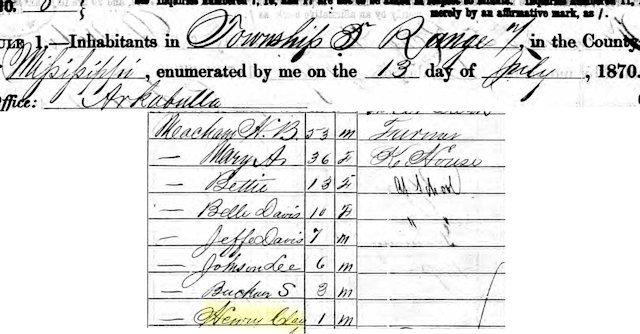 Henry Clay Meacham was born in Mississippi in 1869.
Henry Clay Meacham was born in Mississippi in 1869.
 He began his mercantile career in 1897, opening a store in Huntsville.
He began his mercantile career in 1897, opening a store in Huntsville.
In 1899 he married Margaret Bean.
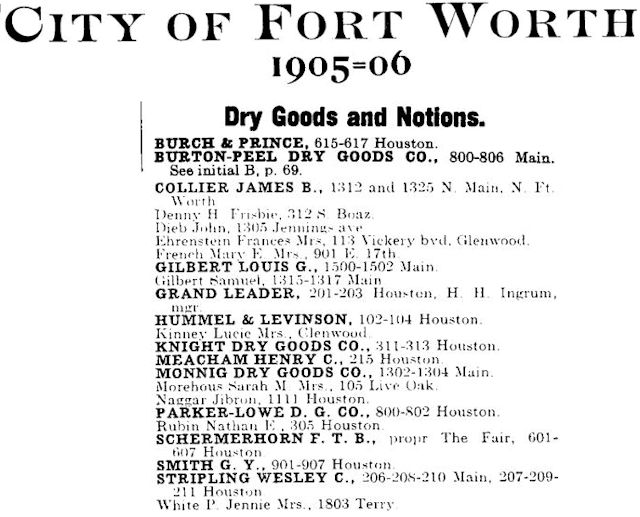 The Meachams moved to Athens in 1902 and to Fort Worth in 1904. In 1905 he opened a store in rented space at Houston and 2nd streets. Already downtown were Stripling’s, Monnig’s, and F. T. B. Schermerhorn’s The Fair.
The Meachams moved to Athens in 1902 and to Fort Worth in 1904. In 1905 he opened a store in rented space at Houston and 2nd streets. Already downtown were Stripling’s, Monnig’s, and F. T. B. Schermerhorn’s The Fair.
Meacham prospered and expanded his store.
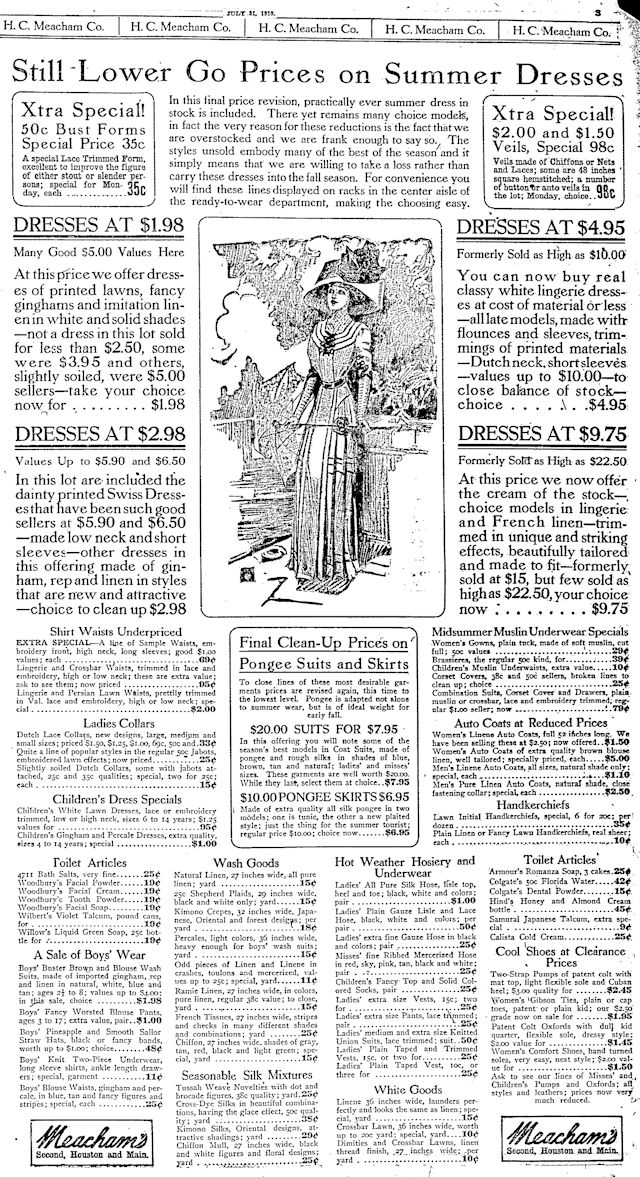 Meacham’s ad of 1910.
Meacham’s ad of 1910.
 In 1914 he moved to a new building at 12th and Main, one block north of Monnig’s dry goods store.
In 1914 he moved to a new building at 12th and Main, one block north of Monnig’s dry goods store.
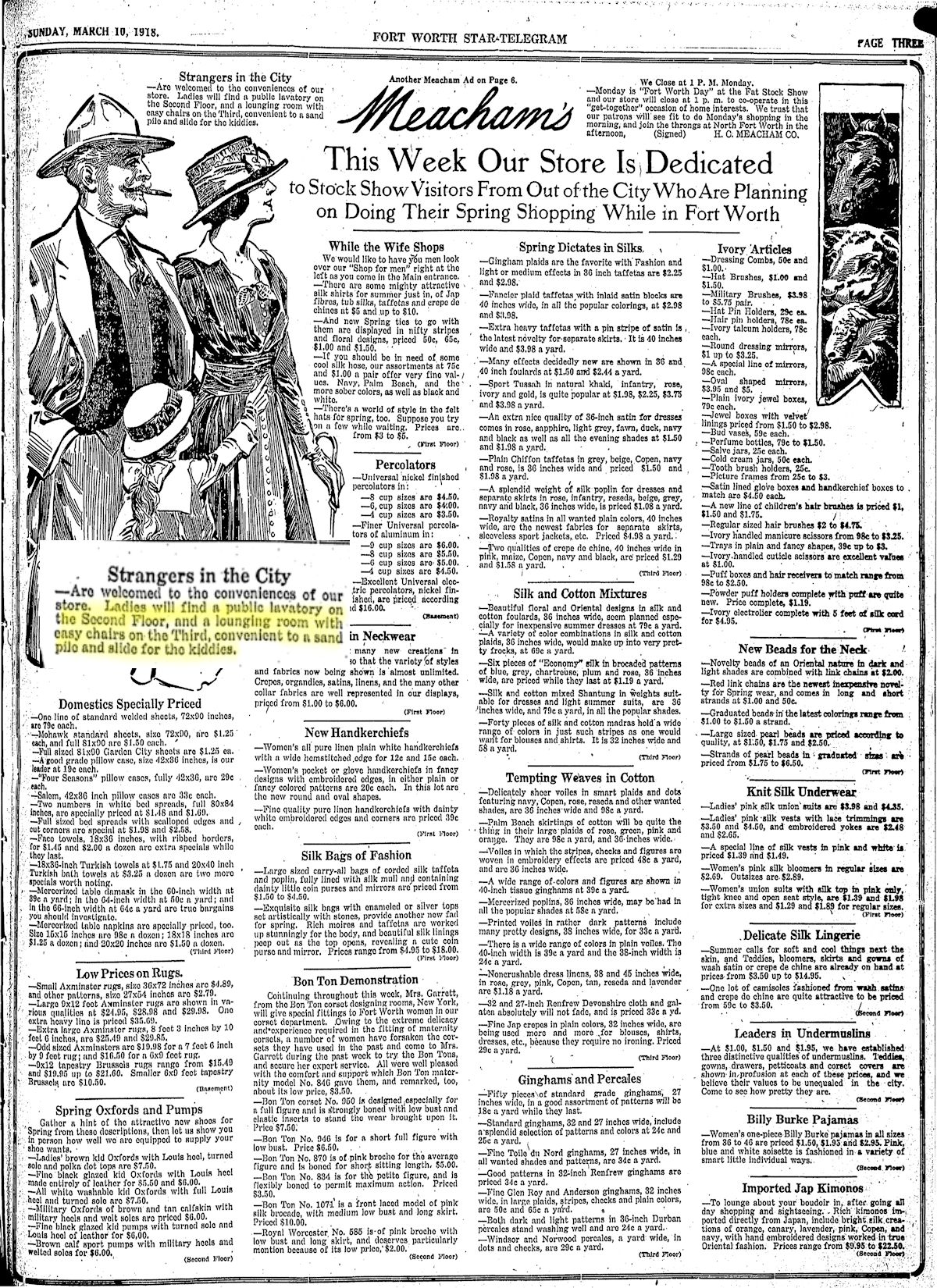 Meacham’s offered women shoppers a public lavatory and lounging room; a sand pile and slide were provided for the smallest shoppers.
Meacham’s offered women shoppers a public lavatory and lounging room; a sand pile and slide were provided for the smallest shoppers.
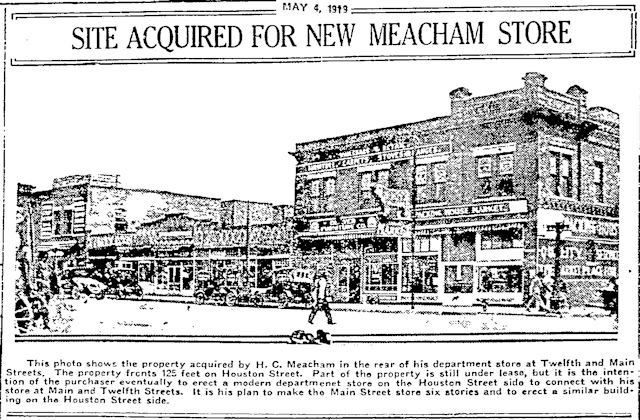 Again Meacham prospered and expanded his second location, building an annex on Houston Street to the west.
Again Meacham prospered and expanded his second location, building an annex on Houston Street to the west.
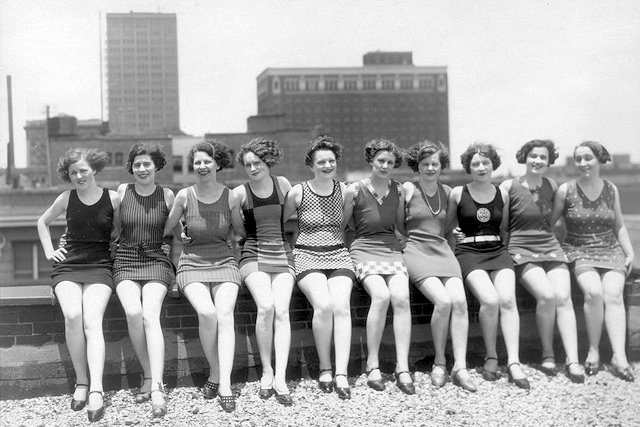 In 1925 Meacham’s swimsuit models went up on the roof of the building to get a bit closer to the sun. In the distance are Farmers & Mechanics Bank and Hotel Texas. (Photo from University of Texas at Arlington Library Special Collections.)
In 1925 Meacham’s swimsuit models went up on the roof of the building to get a bit closer to the sun. In the distance are Farmers & Mechanics Bank and Hotel Texas. (Photo from University of Texas at Arlington Library Special Collections.)
By 1925 H. C. Meacham, long a civic leader, was involved in politics. The Citizens’ Association for Civic Advancement had formed in 1924 to campaign for a new city charter. Meacham was chairman. He helped draw up the new charter, which provided for a council-manager form of municipal government.
The charter was approved in December 1924.
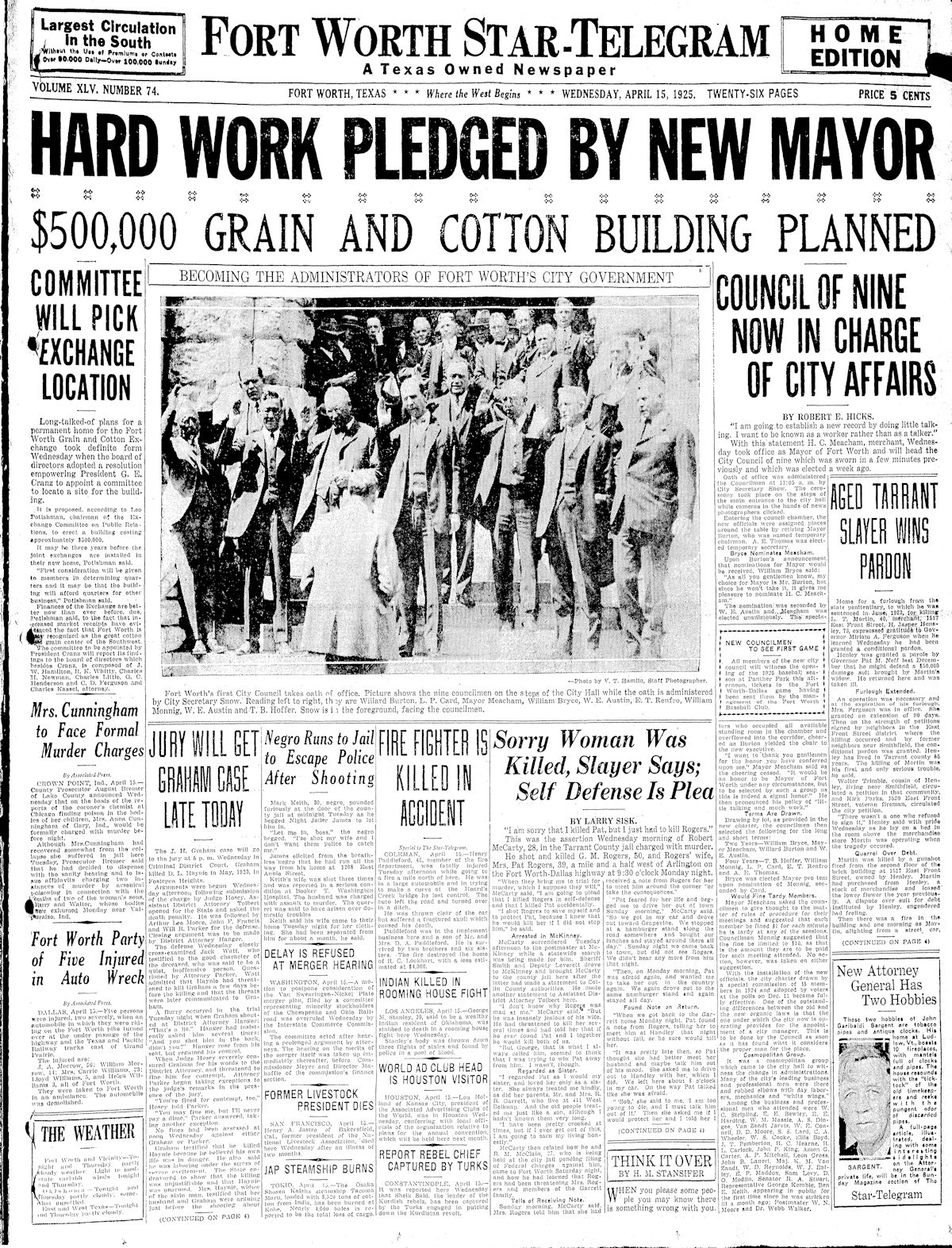 The first city election under the new charter was held in April 1925. Citizens’ Association fielded a slate of nine candidates for city council. Meacham was among them.
The first city election under the new charter was held in April 1925. Citizens’ Association fielded a slate of nine candidates for city council. Meacham was among them.
All nine were elected. The other eight councilmen elected Meacham mayor.
The Star-Telegram gave dominant front-page coverage to the election. H. C. Meacham was the man of the hour.
In 1925 commercial aviation was earning its wings, and civic leaders such as Meacham and Carter wanted Fort Worth to be on the leading edge of those wings. One of the first projects of the new mayor was establishing a municipal airport.
After World War I the Army had given up its lease on Barron Field, one of the three airfields of Camp Taliaferro, and auctioned off the improvements. The field then was used by amateur fliers and flight instructors. But the Army returned to Barron Field, leasing the field to serve as one of the refueling and repair stations of the Army’s Model Airways System. The field had a staff of one.
In 1924 Sergeant William G. Fuller, who was in charge of maintenance and supply of the Texas section of the airways system, was sent from San Antonio to Fort Worth to close Barron Field. Army planes could instead land at Love Field in Dallas.
One day while Fuller was at Barron Field a stranger showed up.
It was newly elected Mayor H. C. Meacham.
Long story short, Meacham used powers of persuasion that even Amon Carter would admire to convince the Army to let Fort Worth provide it with a new airfield for its Model Airways System.
The city had recently leased a cow-pasture runway four miles north of town—much closer to town than Barron Field. Meacham offered to let Army planes land there at no charge.
Fuller later recalled that Meacham asked that Fuller be assigned to manage the new field.
Fuller declined.
Meacham then offered to build a house and dig a well—at his own cost—on the new field for Fuller.
Fuller gave in.
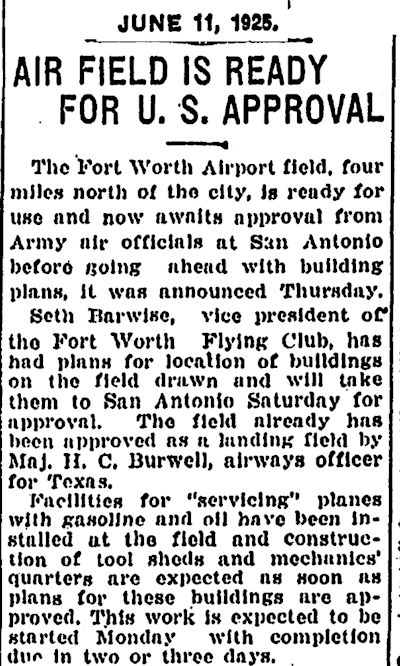 Under Fuller’s guidance the cow pasture evolved quickly into Fort Worth Municipal Airport.
Under Fuller’s guidance the cow pasture evolved quickly into Fort Worth Municipal Airport.
In 1927 the airport was renamed for Meacham and soon became a stop on the national air mail network.
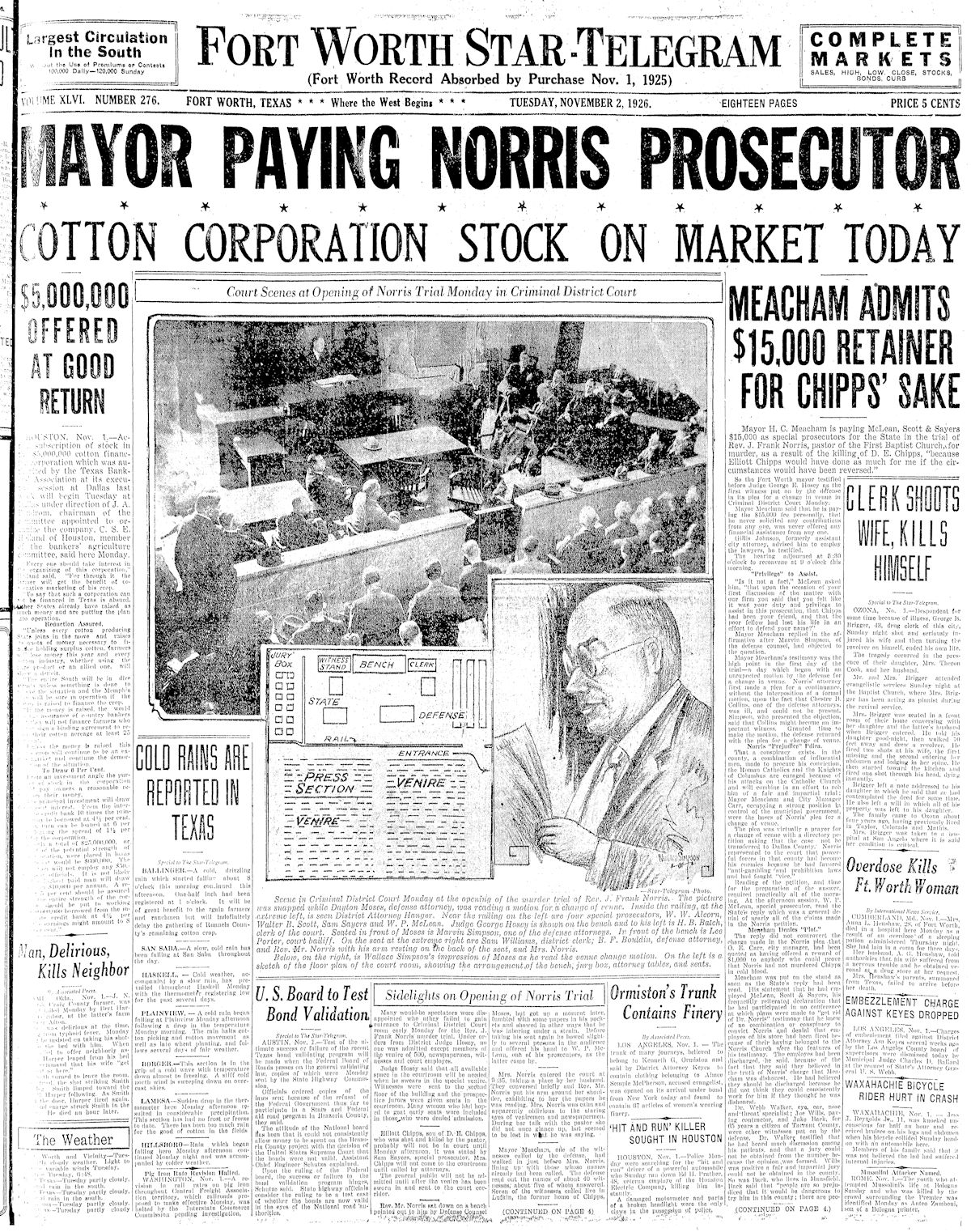 As mayor, H. C. Meacham was among the most influential and conspicuous people in town. Two other influential and conspicuous people in town were J. Frank Norris and Amon Carter.
As mayor, H. C. Meacham was among the most influential and conspicuous people in town. Two other influential and conspicuous people in town were J. Frank Norris and Amon Carter.
Meacham soon got crossways with both men.
First up was Norris, pastor of First Baptist Church.
Norris, who was not keen on Catholicism, said the Meacham administration was “morally corrupt” because Meacham had “known Roman Catholic associations.”
In 1926 Norris preached a sermon against Meacham, accusing the mayor of misappropriating city funds for Catholic causes. Norris drafted a small army of boys to surround Meacham’s department store and hand out to shoppers copies of Norris’s Searchlight newsletter containing the text of the anti-Meacham sermon.
On the afternoon of July 17, 1926 lumberman Dexter Elliott Chipps, a friend of Meacham, walked from his rooms at the Westbrook Hotel to First Baptist Church. He confronted Norris in the preacher’s office. Chipps was, some later said, a drunkard and a bully. Chipps told Norris to stop bedeviling Meacham. Norris would later say that Chipps threatened to kill him. Norris drew a pistol from a desk drawer and shot Chipps dead. Chipps was unarmed.
Meacham paid $15,000 ($215,000 today) to a local law firm to act as special prosecutors at Norris’s murder trial because, Meacham said, “Elliott Chipps would have done as much for me if the circumstances would have been reversed.”
Norris demanded a change of venue, claiming Catholic bias against him in Fort Worth would deny him a fair trial.
The trial was held in Austin.
Norris was acquitted.
 In 1927 Meacham ran for re-election. And he won.
In 1927 Meacham ran for re-election. And he won.
But compare the space that the Star-Telegram gave to his re-election in 1927 and his election in 1925.
On a cluttered front page on April 8, 1927 the Star-Telegram gave equal space to the city council election and a bombing in Collinsville, Oklahoma.
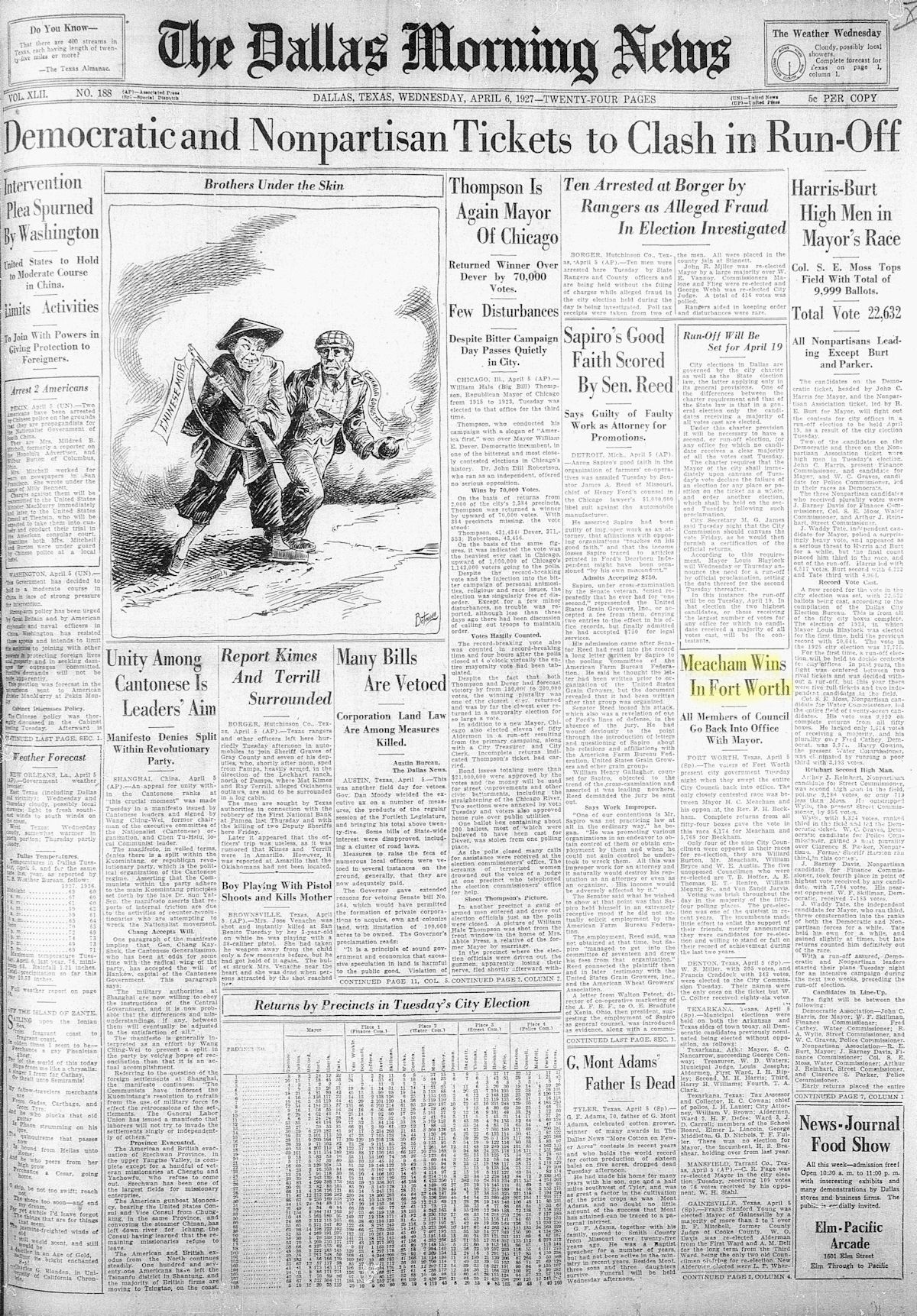 In fact, the Dallas Morning News gave the 1927 Fort Worth municipal election as much coverage as the Star-Telegram did.
In fact, the Dallas Morning News gave the 1927 Fort Worth municipal election as much coverage as the Star-Telegram did.
The Star-Telegram’s man of the hour in 1925 was Mr. Persona Non Grata in 1927.
What happened?
According to Jerry Flemmons in Amon: The Life of Amon Carter, Sr., of Texas, Amon Carter and Meacham feuded over something—perhaps a business deal, perhaps a woman—at some unspecified time, and not only did the Star-Telegram minimize its coverage of Mayor Meacham, but also Meacham’s Department Store ads stopped appearing in the Star-Telegram. Flemmons theorizes that Meacham, not Carter, was behind the break in business. The store since its opening in 1905 had been a heavy advertiser in the Star-Telegram. When the parent newspaper Star began publishing in 1906 Meacham was the first contract advertiser. The loss of advertising cost both companies a lot of money.
I find no Meacham’s ads in the Star-Telegram from June 1928 until January 16, 1930. A year and a half with ads in only the Fort Worth Press, Flemmons writes, severely strained Meacham’s financially.
 Flemmons also writes that the Star-Telegram continued to refer to Meacham Field by its original name—“Municipal Airport”—long after the airport was renamed for Meacham in 1927. On the other hand, the Dallas Morning News referred to Meacham Field as “Meacham Field.”
Flemmons also writes that the Star-Telegram continued to refer to Meacham Field by its original name—“Municipal Airport”—long after the airport was renamed for Meacham in 1927. On the other hand, the Dallas Morning News referred to Meacham Field as “Meacham Field.”
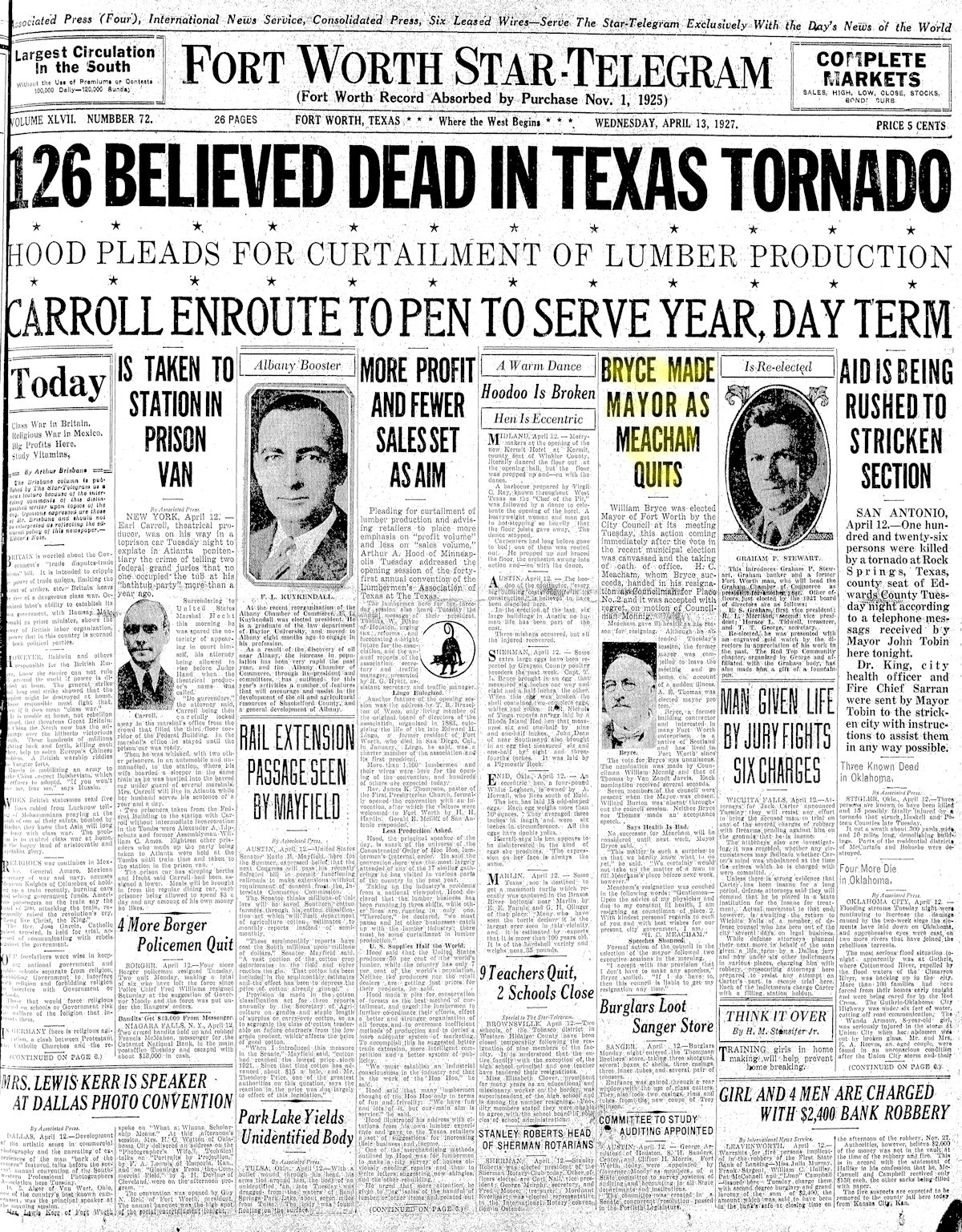 Mayor Meacham resigned a week after his re-election, citing health reasons. He was replaced as mayor by councilman William Bryce.
Mayor Meacham resigned a week after his re-election, citing health reasons. He was replaced as mayor by councilman William Bryce.
 In April 1929 businessman Meacham bought radio station KFJZ and moved the studio to his department store. Shoppers could listen to musicians—among them the Light Crust Doughboys featuring Bob Wills—as the musicians performed on the air.
In April 1929 businessman Meacham bought radio station KFJZ and moved the studio to his department store. Shoppers could listen to musicians—among them the Light Crust Doughboys featuring Bob Wills—as the musicians performed on the air.
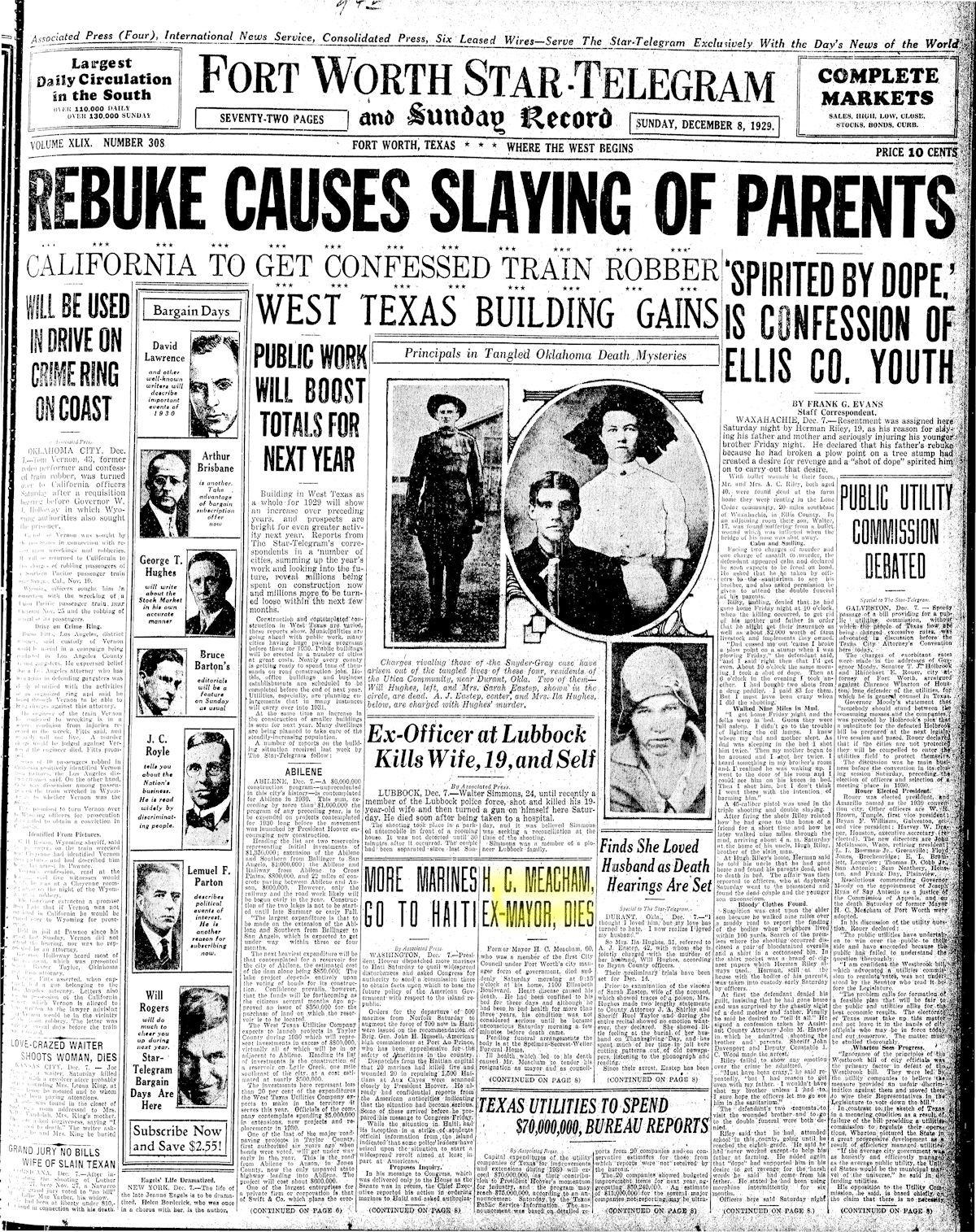 Meacham was planning further expansion of his store and even a hotel when he died.
Meacham was planning further expansion of his store and even a hotel when he died.
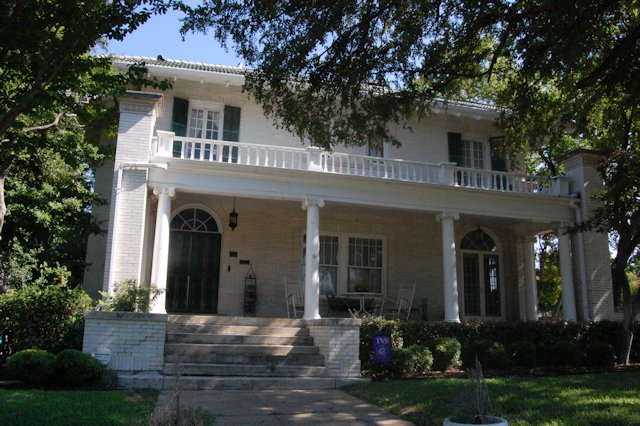 H. C. Meacham died at his home at 1100 Elizabeth Boulevard.
H. C. Meacham died at his home at 1100 Elizabeth Boulevard.
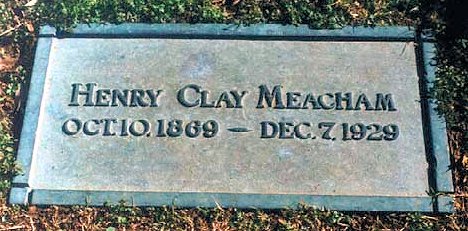 Henry Clay Meacham is buried in Greenwood Cemetery.
Henry Clay Meacham is buried in Greenwood Cemetery.
(Five weeks after Meacham died, Meacham’s Department Store ads again appeared in the Star-Telegram.)
The business outlives the businessman. After Meacham died his wife took over as president of the company.
Mrs. Meacham, active in social and civic circles, was a charter member of the Woman’s Club of Fort Worth. The James F. Moore house in the club compound is officially “Margaret Meacham Hall.”
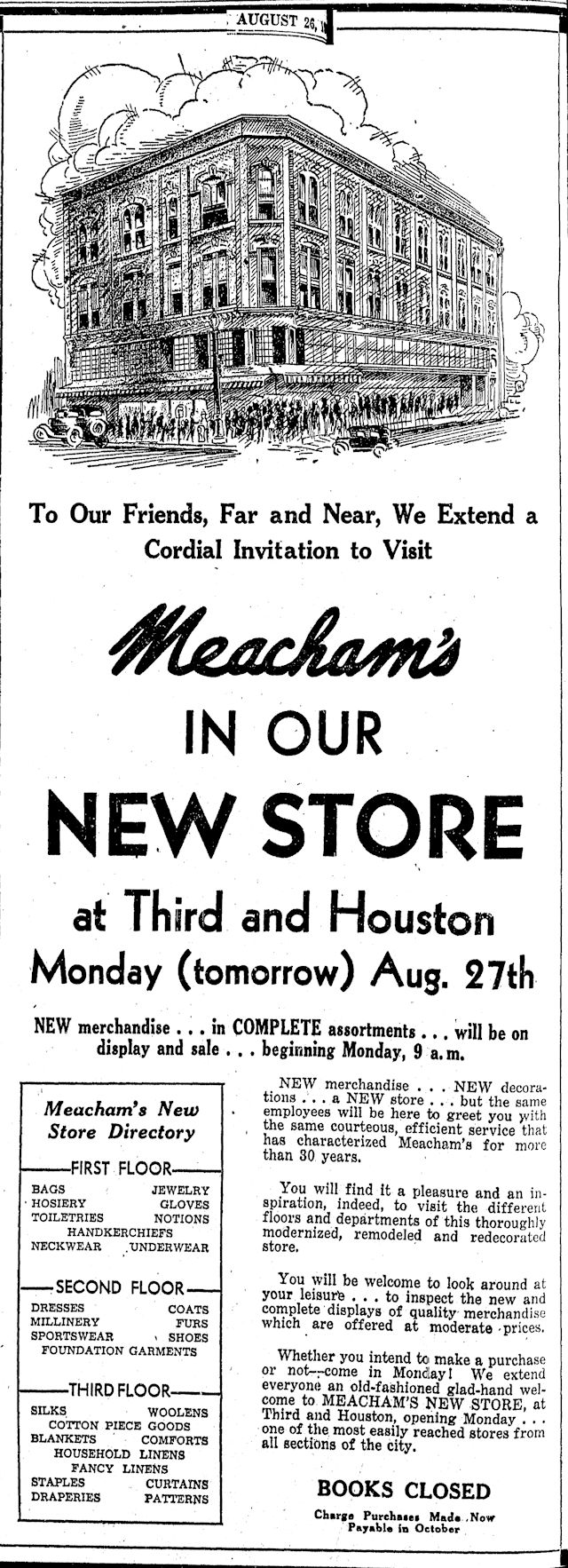 In 1934 Meacham’s moved to a new location at Houston and 3rd streets.
In 1934 Meacham’s moved to a new location at Houston and 3rd streets.
In 1937 Mrs. Meacham sold the store to brothers Seymour and Milton Amstater.
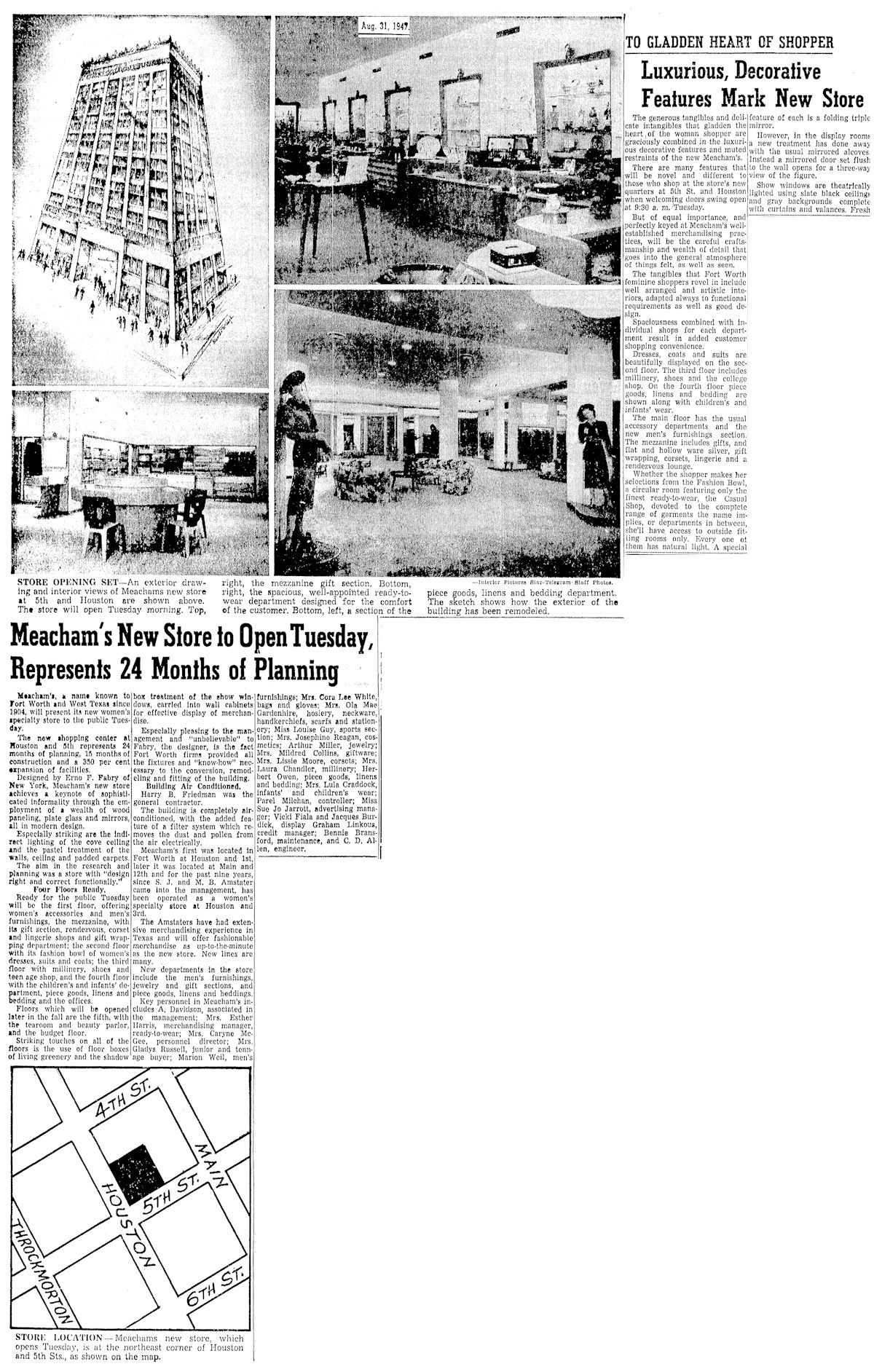
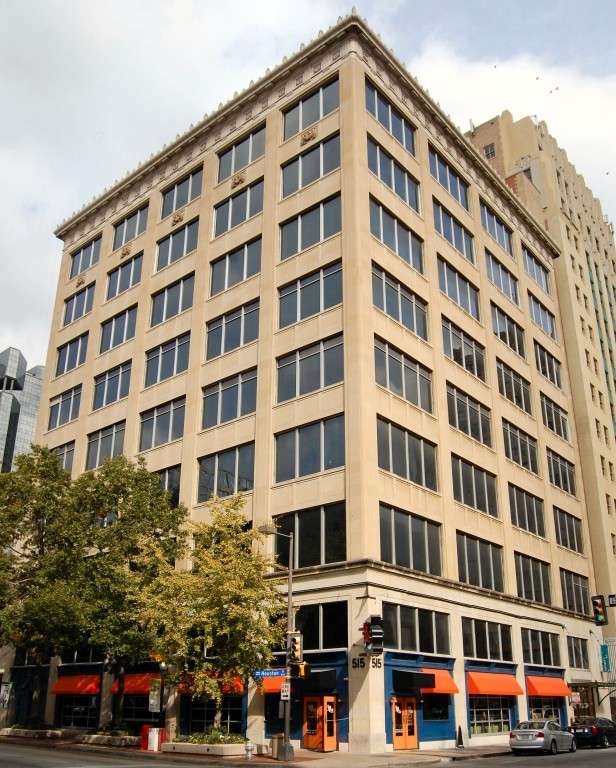 In 1947 Meacham’s moved to this building (Clarkson, 1925) on 5th at Houston Street, originally built for Sanger Brothers Department Store.
In 1947 Meacham’s moved to this building (Clarkson, 1925) on 5th at Houston Street, originally built for Sanger Brothers Department Store.
In the new building Meacham’s became a women’s specialty store.
 In a delightful irony, in 1947 Amon Carter married Minnie Meacham, the daughter of the man he had feuded with twenty years earlier! Finally the Star-Telegram began to refer to Meacham Field as “Meacham Field.”
In a delightful irony, in 1947 Amon Carter married Minnie Meacham, the daughter of the man he had feuded with twenty years earlier! Finally the Star-Telegram began to refer to Meacham Field as “Meacham Field.”
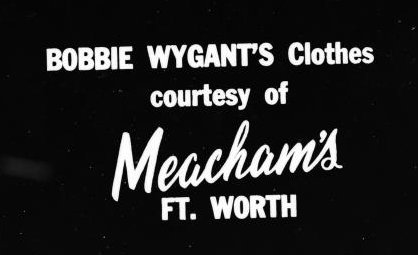 This television title card of 1961 shows that Meacham’s was the official wardrober of WBAP-TV’s Bobby Wygant. (Photo from UNT Libraries Special Collections.)
This television title card of 1961 shows that Meacham’s was the official wardrober of WBAP-TV’s Bobby Wygant. (Photo from UNT Libraries Special Collections.)
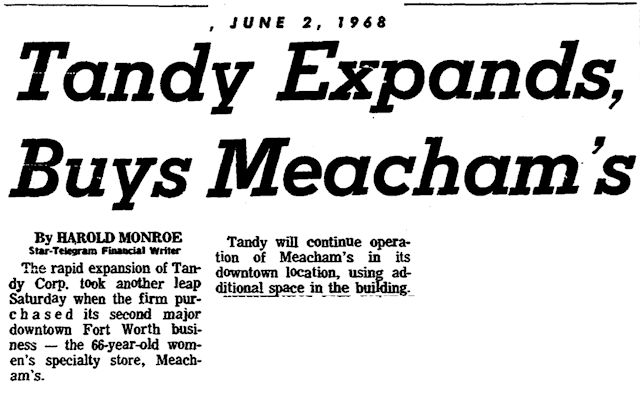 In 1968 the Tandy Corporation bought Meacham’s.
In 1968 the Tandy Corporation bought Meacham’s.
Tandy opened a Meacham’s store in Arlington in 1969 and in Ridglea in 1970.
 In 1971 Tandy announced the closing of the Meacham’s flagship store, ending sixty-six years of business downtown.
In 1971 Tandy announced the closing of the Meacham’s flagship store, ending sixty-six years of business downtown.
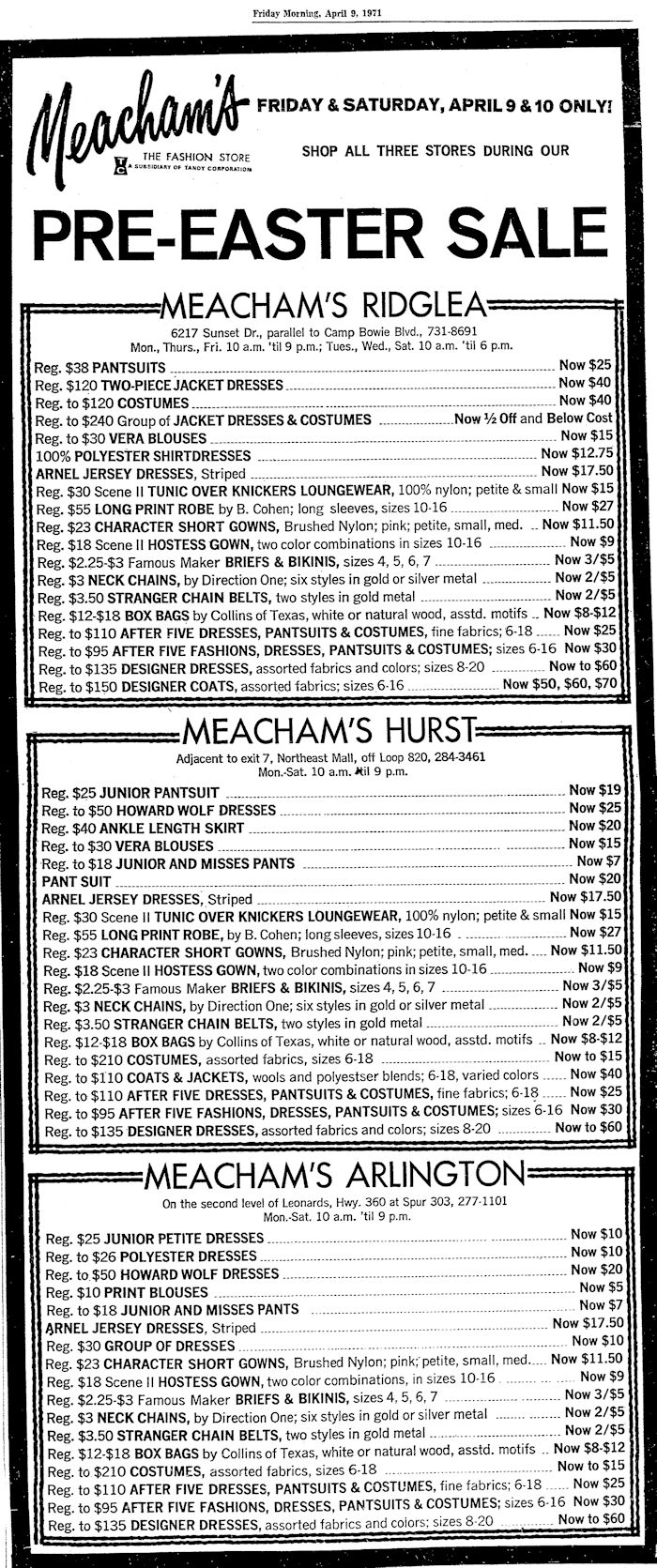 Later that year Meacham’s (“a subsidiary of Tandy Corporation”) opened a third suburban store—in Northeast Mall—in addition to Arlington and Ridglea.
Later that year Meacham’s (“a subsidiary of Tandy Corporation”) opened a third suburban store—in Northeast Mall—in addition to Arlington and Ridglea.
The future of Meacham’s and the other major downtown department stores was in the suburbs.
At least for a while.
 In 1972 Tandy sold the Meacham’s stores to Margo’s La Mode of Dallas. The Meacham’s stores were renamed “Meacham’s Margo’s La Mode.” But by 1974 Margo’s had dropped the Meacham’s name that for more than a century has meant different things to different people.
In 1972 Tandy sold the Meacham’s stores to Margo’s La Mode of Dallas. The Meacham’s stores were renamed “Meacham’s Margo’s La Mode.” But by 1974 Margo’s had dropped the Meacham’s name that for more than a century has meant different things to different people.
(Meacham Middle School is named for educator W. A. Meacham.)






My aunt — my mother’s older sister — was for many years a buyer for Meacham’s accessories, mainly handbags, and also managed the jewelry department. She would go to New York every year to buy for them. I was given to understand that she was one of their most valued employees.
Facinating, I thought the only famous Meachams were in Utah and Idaho….Great stuff!